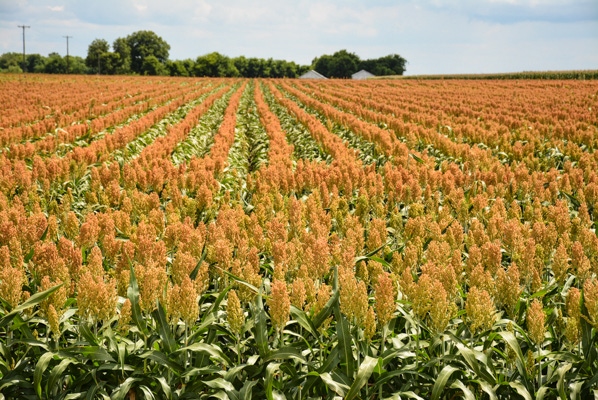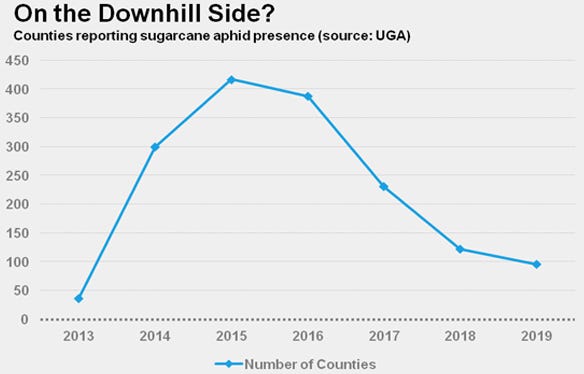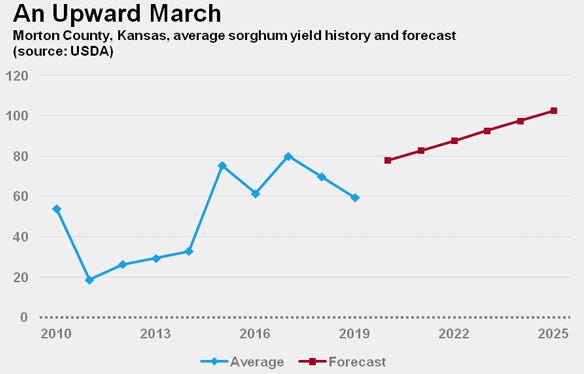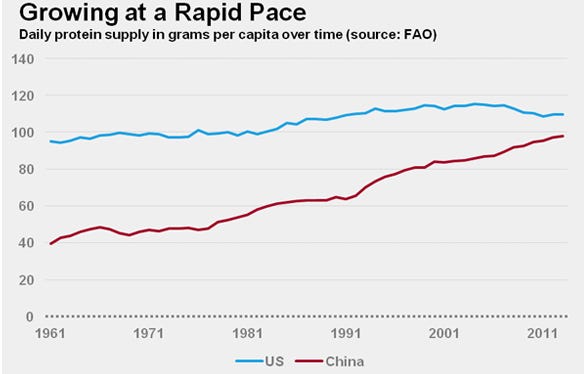December 31, 2019

After spending much of 2018 responding to the Chinese antidumping and countervailing duty investigations into imports of U.S. sorghum, I was convinced 2019 would be a pretty boring year.
Most would agree I could not have been more wrong. From historic floods, to record-breaking droughts, to seemingly unending trade disputes, to the third presidential impeachment in U.S. history, 2019 had it all. Will 2020 top 2019? It’s hard to say, but I’m confident the sorghum industry has a lot of things to look forward to. Today, I’ll focus on four.
Sugarcane aphid pressure trends downward
First and most reassuring to sorghum farmers, the industry seems to be on the downhill side of the sugarcane aphid outbreak that began in 2013. Figure 1 shows the number of counties reporting a presence of the pest in each year since 2013. The pressure in 2019 was a fraction of what it was in 2015, with 96 counties reporting compared to 417 in the peak year for the pest. While it would be folly to say we’ll never see significant pressure again, the trend is clearly toward fewer sugarcane aphids — not more.

Figure 1: Counties reporting sugarcane aphid presence, 2013-2019.

What’s driving this trend and why might it continue? Most importantly, farmers are becoming more proactive and effective with chemical applications. They are treating the pest earlier, applying the correct chemistry and reducing their speed and using more water if spraying with a ground rig. This improved efficacy has led to better control early, which has meant a more limited northward move in each of the last four years. Keep up the good work, sorghum farmers.
In addition to these drivers, sorghum seed companies have invested significantly in sugarcane aphid-tolerant hybrids, and those investments are beginning to pay off. New tolerant hybrids come to market each year, and this pace will only quicken as breeding tools such as doubled haploid become available to commercial breeders. Together, better farm practices coupled with better genetics will one day make sugarcane aphid worries a thing of the past. Will this be true by the end of 2020? Maybe not, but we’re moving in the right direction.
Herbicide tolerance investment starts to pay off
Second, sorghum farmers will soon have three different herbicide tolerance technologies from which to choose. Plant breeding is a time-intensive process, and with fewer resources and an exclusive reliance on traditional techniques, sorghum breeding programs often move even slower.
However, after nearly a decade of investment in herbicide tolerance, the industry’s pipeline efforts are beginning to pay off, and sorghum farmers will be able to see at least two of these technologies in demonstration plots in 2020. Commercial availability is still a year or two away, but the Inzen, Igrowth and ACCase technologies could revolutionize the sorghum industry.
Sorghum genetics, yield performance improving
Third, sorghum has finally turned a corner with regard to crop performance relative to genetic potential. With all the talk of the staggering genetic potential in other crops, the yield potential in sorghum is often overlooked. However, the highest sorghum yield ever recorded in the U.S. was 249 bushels per acre, and yields upwards of 270 bushels have been reported in Mexico for years. Moreover, breeders today believe a bag of sorghum seed has the potential to produce well over 300 bushels provided the impacts of yield-limiting factors such as disease and weed pressure can be minimized.
So, what about actual yield performance? It’s exciting to report things are looking up. The 10-year national average sorghum trend yield is increasing by approximately 2.6% per year, and if this trend holds, 2020 could see a national yield record of almost 79 bushels per acre.
While the projected corn yield for 2020 is much higher, the trend yield is actually increasing at a slower rate than the sorghum trend yield. Does this mean sorghum is improving faster than corn? Maybe or maybe not, but we’re at least keeping pace. That’s a cause for celebration.
The story is even better in certain individual counties. Figure 2 depicts the average sorghum yield history and trend-based forecast for Morton County, Kan. The trend yield is actually growing by approximately 6.3% per year, and this is a common statistic in counties across the Sorghum Belt.
Simply put, the difference between the yields seen today and those seen during and immediately after the 2011-2012 drought are dizzying. And looking forward a few years, the contrast is even starker. Sorghum genetics are improving at a strong pace.

Figure 2: Average sorghum yield history and forecast in Morton County, Kan.

Demand for ag products remains strong
Finally, the fundamental need for U.S. agricultural products is still strong. Figure 3 illustrates China’s rising per capita protein consumption, which will eclipse our per capita protein consumption here in the U.S. by 2041 if the trends hold. Even if the country’s population has stagnated by that point, China’s total protein demand growth has really just begun.
Excitingly, China isn’t the only country with a growing population, increasing per capita income and rapidly changing dietary patterns. India looks a lot like China did 25 years ago from a per capita income standpoint, and while there are several factors that could keep India from becoming the demand powerhouse China has become, the country’s protein needs will rise — it’s just a matter of how rapidly.

Figure 3: Daily protein supply in grams per capita over time.

The huge caveat here is trade relations must be normal if we’re to truly take advantage of this demand. Fortunately, as I write this, things are looking up on that front, and final USMCA and China deals seem to finally be on the horizon. Of course, 2019 was a wild ride in large part because we seemed finished with both of these deals only to watch them implode multiple times.
So, as always, we must proceed with caution. However, deal or no deal, the world needs U.S. agricultural products.
U.S. agriculture — and the sorghum industry in particular — definitely has a lot to look forward to. I can’t wait to see what 2020 brings!
Duff is a strategic business director for National Sorghum Producers. He can be reached by email at [email protected] or find him on Twitter @sorghumduff.
About the Author(s)
You May Also Like






